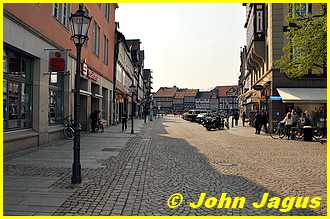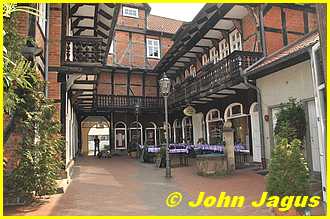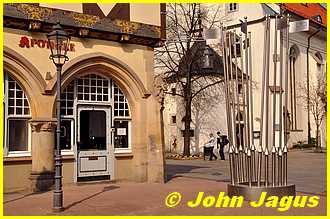Guest Page No. 10
Home From Home - Ilkestonians
Abroad
10 - Germany
|
John Jagus was born in Ilkeston in 1955, the only
son to Theodore (Theo) and Edith and was brought up with his
three elder sisters in the town. Theo was a Polish refugee and
a local miner who sadly lost his life at an early age but John's
mother, who later remarried, and his sisters still live locally.
John however has made his home in Germany for over 30 years and
has been happily married to Kerstin for more than 8 years having
first met there in the early 1970s when he was serving with the
British forces. Employment prospects at that time in England
were not good and as his army contract came to an end, he decided
to stay in Germany which is still his base although he works
world wide as a service technician for the German company Hartmann
Valves. His home is in Celle, the capital town of the district
of Celle, in Lower Saxony which is where all the images on this
page sent to me by John were captured. So let's enjoy this slice
of life from another Ilkestonian abroad.
|
 John and Kerstin actually live
about 5km east of Celle in a small village called Garssen but
they made that short trip into Celle for these images. John and Kerstin actually live
about 5km east of Celle in a small village called Garssen but
they made that short trip into Celle for these images.
Celle is a town with in excess of 70,000 inhabitants situated
about 50km north east of Hanover. It is twinned with the English
town of Tavistock in Devon and has a history that stretches back
over 700 years. That history includes being the official residence
between 1378 and 1705 of the Lüneburg branch of the Dukes
of Welf who had been banished from their original Ducal seat.
Today Celle is noteworthy for having a picturesque old town centre,
the Altstadt, complete with many timber-framed buildings and,
as is apparent from John's photos, some lovely streets and squares.
 
|
 The oldest building in the town
with foundation walls dating from 1292 is the Schloss Celle or
Celle
Castle which is sometimes even referred to as Celle Palace.
Schloss, castle or palace the four-winged building is the largest
such structure in the southern Lüneburg Heath region of
Germany. The oldest building in the town
with foundation walls dating from 1292 is the Schloss Celle or
Celle
Castle which is sometimes even referred to as Celle Palace.
Schloss, castle or palace the four-winged building is the largest
such structure in the southern Lüneburg Heath region of
Germany.
It was built in the renaissance and baroque style and has a unique
chapel with renaissance features from the sixteenth century that
have been painstakingly preserved. The castle was one of the
residences of the House of Brunswick-Lüneburg and includes
the seventeenth century early baroque style state chambers, an
eighteenth century kitchen and the oldest theatre still in use
in Germany but these three images from John were all taken outside
the castle in the vicinity of the moat.
 
|

Another large brick building in the town that has been restored
and now serves as the New Town Hall (Neue Rathaus) and Celle
Council Offices was built between 1869 and 1872 as the barracks
for the 77th Infantry Regiment. It was renamed in 1938 as the
Heidekaserne (Heath Barracks) and after the Second World War
was used by British troops until 1993.
|
 
The area around the Heidekaserne has now been transformed by
residential buildings and a town park has also been created around
the building. Germany's recent history is never far away however
and this photo (above right) is a reminder of the Nazi era showing
one of many brass plaques that are dotted around the town naming
Jews that were never to return.
|
 
 Returning to
the Old Town area, these three images above and right come from
The Stechbahn which was the former show ground and tournament
venue. It was built about 1530 and the "Löwenapotheke"
(Lion Pharmacy) seen here in John's photo on the right was the
former Court Pharmacy until 1849. A horseshoe built into the
pavement in front of the building marks the spot where Duke Otto
the Magnanimous is said to have accidentally been killed after
falling from his horse during a tournament in 1471. Returning to
the Old Town area, these three images above and right come from
The Stechbahn which was the former show ground and tournament
venue. It was built about 1530 and the "Löwenapotheke"
(Lion Pharmacy) seen here in John's photo on the right was the
former Court Pharmacy until 1849. A horseshoe built into the
pavement in front of the building marks the spot where Duke Otto
the Magnanimous is said to have accidentally been killed after
falling from his horse during a tournament in 1471.
The Stechbahn and surrounding area was redesigned in 2004/5 to
make it more attractive for citizens and visitors, due reference
being made to its historical background. A feature also to be
seen in John's photo on the right is an artwork of the "Lances
before the Lion Pharmacy".
|
 A building that commands a lot
of attention in the Old Town is the Hoppener House (left), an
attractive timber-framed house built in 1532. A building that commands a lot
of attention in the Old Town is the Hoppener House (left), an
attractive timber-framed house built in 1532.
But something not quite so obvious and which John acknowledges
that it is the first time he had noticed it, is the crown around
a nearby tree (right).
|

|

Occupying almost the whole of one side of the Stechbahn is the
700 year old church of St. Marien with its 74.5 metre high tower
from where hymns are played on a trumpet twice each and every
day.
|

If England's cuisine is known for its fish and chips (although
curry is now high on the menu too) in Germany it is the sausages
that are available from fast food outlets and in Celle it is
not unknown for John and Kerstin to call in Eisrmann's schnell
imbus (quick food) opposite the town church for a snack.
 
You might say you can take the lad out of Ilkeston but you can't
take Ilkeston out of the lad!
|
For the last two images we leave Celle and go to
John and Kerstin's home in Garssen and I'll let John take up
the story:
"Last winter it being cold and with the early dark nights
I had a bright idea to make something for our back garden. So
I came up with a finger post, they are quite common even here
in Germany. The post as you can see has four directions, all
the wood is oak and it took a few winter months for me to carve
out all the names using only traditional tools."

The four directions are as follows: north is Bergen, Norway 1214km
a place where John has worked; south is Schladming, Austria 888km
where Kerstin's parents used to live; east is Rusinowice, Poland
772km where John's father was born and west is Ilkeston 1074km
where John was born. Whilst finger posts are common John adds
"one in your back garden is not so common and with Ilkeston
1074km in one direction - that's one long walk!"
|